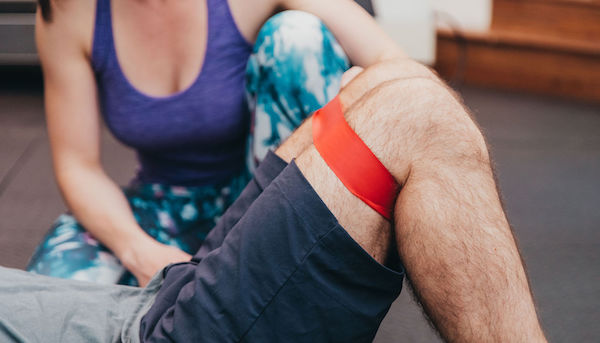Rubbing sunscreen into your hair instead of your skin means you won't get you the UV protection you're looking for. As common sense as that seems, many of us approach stretching in an equally pointless, or even harmful, way. Stretching is not just for flexibility but, as we'll uncover in this article, muscle growth, shape and overall strength.
Read on to get the most out of your next stretch, whether static or dynamic. Keep the sunscreen where it belongs and ensure you get the most out of each stretch with some simple tips.
The Benefits of Stretching
We can’t understate how vital stretching is for general health. An excellent study to illustrate this came out of the University of Miami. Focusing on 28 subjects with chronic back pain, researchers wanted to see how stretching might improve their rehabilitation.
Participants were separated into two groups. One went through the necessary rehab program while the other did the same with the addition of stretching exercises. After two weeks, both groups reported reduced pain, but the group who went through the additional stretching reported marked improvements. [1]
“Dynamic stretches are becoming increasingly popular as new research expands our understanding of their benefits.”
If your aim isn't to recover from injury but to increase strength it's still a good idea to keep stretching in mind. According to a paper published in the Journal of Applied Physiology, stretching your muscles also makes them stronger. [2]
Bodybuilders are taking it even further! Many are implementing short, weighted stretches into their weightlifting program. Based on older animals experiments, many researchers are discovering that humans can improve muscle growth significantly with the use of intense stretching between sets of lifts. [3]
It's believed that part of this is due to the creation of both a large amount of mechanical tension and hypertrophy (muscle damage and repair that leads to growth). Exercises that take advantage of this include:
- Hanging from your arms on a pull-up bar to stretch your back
- Maintaining a slight bend in elbows during a chest fly and allowing dumbbells to stretch your chest
Many of these benefits come from an understanding about what kinds of stretches to performe and how. Again, it's how and where you apply the sunscreen that counts.
Dynamic Versus Static Stretching
Stretching is the act of extending a muscle or muscle group, sometimes to the point of slight discomfort, to improve elasticity, range of motion and overall flexibility. It comes naturally to most of us when we get out of bed in the morning or when we sit for too long. Not all stretches are the same, however, and they can be broken into two general categories: dynamic and static.
Static stretching is what most of us think about when we think about stretching. Bending over to touch your toes and holding the position, for example, is a typical static stretch. Many of us learned that these kinds of stretch-and-hold routines would help us avoid injury when done before any athletic performance. Recent scientific literature tells us something different. [4]

A meta-review covering ten years of stretching publications revealed statistically significant evidence that static stretching done before strength and power activities causes reduced performance. Cardio activities are also affected as static stretching also reduces speed and agility. [5] For runners (200m or more) or cyclists, static stretching has also shown to have a negative impact.
These reductions in performance aren’t to say that touching your toes doesn't have its place. When it comes to fitness and body aesthetics, static stretching after a workout has proven to have some great benefits. One of the benefits is a better shape for your muscles if you weight train. Stretching loosens your fascia (the band or sheet of connective tissue beneath the skin), as your muscles grow during exercise, looser fascia allows your muscles to separate and creates a more defined look. [6]
In terms of health, a study of 42 participants discovered that static stretching over five weeks led to increased flexibility. [7] This was done without additional strength training, but stretching alone. This discovery is especially important for seniors. For those of us in or nearing retirement, the longer our static hamstring stretch the greater benefit to our flexibility. The benefit tops out at 60 seconds, so hold that stretch! [8]
As the name might tell you, dynamic stretching involves movement between two end-range poses performed for 20-30 seconds. These stretches are becoming increasingly popular as new research expands our understanding of their benefits.
The previously mentioned meta-study, for example, provided evidence that dynamic stretching improves strength and power when performed immediately prior to an event. [7] It actually reverses the temporary adverse effects of static stretching. It was also discovered that in amateur athletes, dynamic stretching increased agility.
If you’re wondering how much to stretch follow the FITT (Frequency, Intensity, Time and Type) principle. Optimize your benefits from stretching at a Frequency of 4-7x per week, and Intensity of a gentle pull, for a period of Time which differs between dynamic and static. 20-30 seconds are all you need for dynamic stretches. Static stretches are most effective at 30 seconds for under 60 years old, and 60 seconds for older. As for Type, remember dynamic stretch before exercise, static afterwards for best results.
Getting the Right Stretch
On your fitness or rehab journey, knowing the right stretch can mean make a world of difference. Understanding which stretches works in what situation, and how to implement it is part of what we do here at Symmetrix. Our staff of trained kinesiologists will be able to access your needs and work together with you to develop a regime to get the most out of your exercise.
We can show you the proper stretch for your routine. Contact us today and discover how we can help you achieve your health goals.
1 https://europepmc.org/abstract/med/1533060
2 https://www.physiology.org/doi/pdf/10.1152/japplphysiol.00952.2006
4 https://onlinelibrary.wiley.com/doi/full/10.1111/j.1600-0838.2009.01058.x
8 https://academic.oup.com/ptj/article/81/5/1110/2857600







